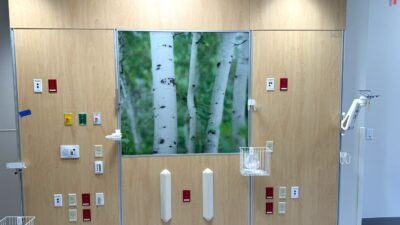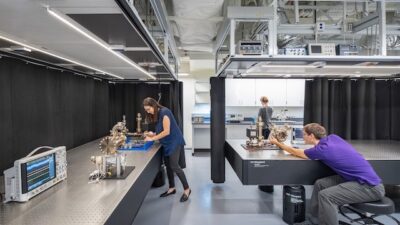CSE: Lets talk about codes. For electrical system design, the Joint Commission on Accreditation of Healthcare Organizations (JCAHO) mandates National Fire Protection Assn. (NFPA) 70, 110 and 99. What are the basics under NFPA 70 that hospitals have to meet? GILSON: Hospitals are required to provide emergency power for life-safety purposes, which often is confused with patient safety.
On Oct. 19, 2006, Consulting-Specifying Engineer moderated a roundtable discussion sponsored by ASCO Power
CSE: Lets talk about codes. For electrical system design, the Joint Commission on Accreditation of Healthcare Organizations (JCAHO) mandates National Fire Protection Assn. (NFPA) 70, 110 and 99. What are the basics under NFPA 70 that hospitals have to meet?
GILSON : Hospitals are required to provide emergency power for life-safety purposes, which often is confused with patient safety. But a life-safety branch of emergency power is for egress purposes—emergency communications—as the first priority of emergency load pick-up from transfer switches.
But the most critical branch is dedicated to patient safety. As the codes have developed over the years, these branches have become larger, because code allows for additional loads to be added to this critical branch. Previously, the equipment branch, which serves air-handling equipment, mechanical equipment and medical air/vacuum systems, was considered a subdivision of the critical branch. Because of the sizes now required, an equipment branch is considered its own branch of power.
Additionally, where code requires facilities to place the heating for patient comfort on emergency power systems, we are required to add the fan horsepower loads of the air-handling systems to the equipment branch, which is a significant load.
PETRIC : I believe that JCAHO generally leaves it up to the facility to determine its individual needs. One of my hospital clients was without utility power for more than 14 hours. One of the concerns was being able to deliver foodservice to patients. So my client wanted to put some kitchen equipment, as well as some central sterile equipment, on the equipment power system.
Obviously, cooling is another big concern, because facilities want to keep patients comfortable in the hospital during the summer. These are some of the more common loads that I’m seeing healthcare facilities add to their emergency power systems.
CSE: Where does master planning fit into this process? Can you outline some of the basics to shoot for in designing an emergency power system within a master plan?
PETRIC : I present options to the owners and design the systems that work best for them. I’ve performed services where the clients exceeded my recommendations and backed up their entire facilities with emergency power systems—because they want to be totally independent of utility power in a catastrophic event. Other facilities have wanted to ramp up emergency power capacity with a system designed for modular expansion as the campus grows.
CSE: From a construction perspective, is this a giant nightmare, especially if you’re going to do this over a four- or even five-year period?
BROWNRIGG : It’s about competing interests. There’s always a fixed dollar amount—or at some point, there’s a fixed dollar amount with the board of directors. It’s wonderful to sit here and say that because we’re talking about emergency power, that’s the most important thing. But in reality, there are hundreds of things that come before. You’re competing with an annual capital budget. And you’re competing against a new piece of radiology equipment or a new cath lab. Emergency power is competing against pieces of equipment with a return on investment that’s easier to see.
I also think that if you’re in an institution that’s had a [power] problem, you probably have a greater ability to get funding for it in a master plan. Once you’ve experienced a problem, it becomes a higher priority.
PETRIC : One of the keys is to present the issue to the board or trustees and actually explain what options are available. You’d be surprised at how well they listen and understand the problem, and can decide on a system option that best meets their needs and budgets.
CSE: Are your healthcare clients proactive about master planning? Are they involved, or is it something really hard to push?
GILSON : We’re seeing a shift to where engineering is joining in the architectural master planning of the facilities. This document or roadmap assists owners and planners in understanding how engineering affects their infrastructures and helps to identify focus points. For instance, two clients have engaged us in 10-year master plans to increase their electrical and mechanical infrastructures to match where the master plan roadmap is taking them.
KESLER : I agree. It’s a necessity. I’ve seen projects where architects have planned major expansions, and they started the design processes, only to have engineering come in later, look at the infrastructures, determine that the architects need all of these upgrades and all of this work, and the projects died because of it. The architects hadn’t planned for that initially in their budgets.
CSE: How about the whole idea of how you approach construction and procurement? I mean aren’t people planning together much earlier now? Not only are the engineer and architect involved, but the construction contractor—even vendors—are all brought in early. They’re saying, “What can we do to get this equipment at a decent price more quickly?”
J. BROWNRIGG : There’s no question. The earlier you bring financial or cost information to the design, you help make the decisions. Sometimes stuff gets cut that maybe doesn’t have to, doesn’t need to get eliminated from the budget, but it does because there’s no real cost information associated with those design decisions.
CHISHOLM : That’s the reason we’re seeing commissioning agents. In fact, we’re getting more commissioning assignments. We’re being brought in more and more to do what you’re talking about—to help bring the money in up front. A lot of times, engineering firms now are being brought in first and they’re selecting the architects, kind of a reversal in roles so to speak.
CSE: How about equipment procurement? Let’s say that a firm has a relationship with Caterpillar. So they get Cat’s gensets cheap. But the engineer says, ‘I want to go with this other modular bi-fuel system. My design really can’t work without it.’
GILSON : We work with different university hospitals and a few county hospitals, and it varies by state and by their rules of procurement. For example, for one state, if you don’t have three manufacturers, you can’t put the drawings up for bid. You can’t say ‘or architect/engineer approved equal,’ or anything, even though the facility might have a preference. It’s got to be bid by three manufacturers. Then another state-owned facility might say they have an approved list of acceptable manufacturers we have to use, and some may be proprietary.
CHISHOLM : We’re encouraging our clients—hospital people, facility directors and construction departments—to become equipment savvy before they get to the stage of selecting an engineering firm. So, they’ll pretty much know what they want before they get there. They’re trying to cut out a lot of excess profit, whatever that means, that [in the past] was paid to general contractors and others, so they’re trying to go direct and cut their own deals.
CSE: That brings up an interesting question about knowledge of equipment and knowing what you want. What is the equipment vendor’s role in the whole process?
CHISHOLM : Engineers should never have to buy lunch. Every vendor out there wants to do a lunch-and-learn. So getting the information isn’t an issue.
BROWNRIGG : Yes, it’s about getting the information, but it’s also about building avenues to get real information. What I mean is access to the owner. In the traditional construction world supply chain, from owner to manufacturer is like tin cans with a string—or like the kids game with telephones. I can sit here and tell you something, and we go around the room, and what I told you and what he hears are exactly opposite—or at least, very different. Because before any contracts are written, information can flow freely. But once contracts get written, oftentimes there are roadblocks to that information.
The vendor should, from the perspective of controlling its own destiny, develop that ability to transfer that knowledge and information. The same goes for the owners. There needs to be a tighter connection between what your true needs are in the facility and what manufacturers are designing.
CSE: But then can’t the facility director just get rid of the engineer?
WILLEY : The discussion so far has been really focused on the engineer selecting the equipment and designing it appropriately. As a facilities person, I take issue with that, because I know my organization. I know what’s in my buildings. I know what equipment can be maintained, where I can service it and with whom. So I would caution against any hospital accepting across-the-board whatever is designed for them—without a great deal of investigation and listening to the whole story. Because, in Great Falls, Mont., let me tell you, there is equipment. But if we get it there, I couldn’t get serviced for love or money.
Certainly you want input from the engineer. And you want to hear what the vendors have to say and what they can provide you. But facilities managers have to be responsible about the long-term operations. You [engineers] all go away, but we still have to keep things going.
CSE: One thing I’m hearing loudly and clearly is the need for a well thought out maintenance and operations plan — and a good commissioning process. So that when someone says, I don’t know how to work this thing; everyone’s gone and I don’t know what to do.
WILLEY : A great deal of our discussion in the planning phase is cost of operation. I don’t care if it’s a light fixture, a refrigerator or a generator. What’s it going to cost to operate it? How much maintenance? Can I get the parts and pieces easily? And is it similar—if not exactly like—what we now have, so that we’re not doing a whole retraining program. Any time you have two separate pieces of equipment that operate differently, you have risk of error.
PETRIC : One of our services, when a project is closing out, is making sure that equipment and systems are demonstrated to the owners and that they receive proper instruction. We routinely videotape training sessions so that if facility staff changes, you can show them a video rather than calling back the vendor or relying on someone else to interpret the vendor’s instructed. By doing so, you can maintain a file of training instructions and demonstrations performed by the manufacturer’s representative for equipment and systems.
DEITSCH : When we start bringing up the system, and when we run it for six months, the engineers are there. Because in case we have a problem, or we find something that the design team didn’t think of along the way, they’re there. It’s more of an interaction as a whole team—the engineers, the architects, the hospital team, the construction team. We all act as one unit.
CHISHOLM : I think you’re fortunate if you’re brought into that. One of the biggest problems we find is that the facilities department is not part of the design team. All of a sudden you end up with the facility manager losing faith in the engineer who designed it, mainly because there was no communication back and forth.
WILLEY : Part of that is you don’t give them a choice. I’m there.
CSE: Do you mandate commissioning? Is that part of the process?
WILLEY : We have started. It’s good. For the big plant add-on we did, it worked really well. And so with a current building project, we’re commissioning as well.
PETRIC : There are so many interfaces needed between the different mechanical and electrical systems now that some components can get left out unless you do commissioning. You need to make sure who’s providing the interconnection and that it is completed so that the system works as intended.
WILLEY : And then you connect it to existing buildings on top of it. It’s just getting more complicated.
BROWNRIGG : We talk about commissioning with a small “c”, which is commissioning the system equipment. Commissioning with a capital “C” is involvement in the master planning—at the very beginning, when you set what your commissioning requirements are. This, of course, finishes with little “c” commissioning and then goes into transition to stabilized occupancy, which is where you optimize your system.
Commissioning in the equipment world largely means commissioning a piece of equipment or system, when commissioning from a facilities management perspective is about from master plan and design through stabilized occupancy.
Participants
Jim Brownrigg
Vice President of Healthcare
and Research Projects
Turner Logistics LLC
New York
Dan Chisholm
President
MGI Systems
Orlando, Fla.
Kevin Deitsch
Manager, Facilities
Saint Joseph Hospital
Denver
Rick Gilson , P.E.
Senior Engineer
KJWW Engineering
Consultants
Rock Island, Ill.
Scott Kesler , P.E.
Director of Electrical
Engineering
OWP/P
Jerry Petric , P.E.
Partner
Korda/Nemeth Engineering
Columbus, Ohio
David Stymiest , P.E., CHFM, SASHE, CEM, GBE
Senior Consultant, Compliance and Facilities Management
Smith Seckman Reid
Slidell, La.
Dawn Willey
Manager, Facilities
Benefis Healthcare
Great Falls, Mont.
Jim Crockett
CSE moderator



